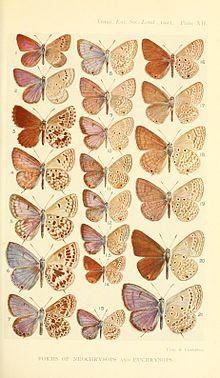| Orachrysops niobe | |
|---|---|
 | |
| Figure 1 | |
| Scientific classification | |
| Kingdom: | |
| Phylum: | |
| Class: | |
| Order: | |
| Family: | |
| Genus: | |
| Species: | O. niobe |
| Binomial name | |
| Orachrysops niobe (Trimen, 1858) | |
| Synonyms | |
| |
Orachrysops niobe, the Brenton blue, is a species of butterfly in the family Lycaenidae and is endemic to South Africa.
The wingspan is 24–38 mm for males and 22–42 mm for females. Adults are on wing from October to November and from February to March. There are two generations per year.[1]
The larvae of the first two instars feed on the leaves and later instars on the rootstock of Indigofera erecta. The larvae are found in holes at the base of their host plant. They are attended to by Camponotus baynei ants.
The species was discovered in 1858 by Roland Trimen at Knysna in Western Cape Province of South Africa.[2] It was not seen again until 1977 when Dr Jonathan Ball of Cape Town found a population at Nature's Valley 50 km to the east of Knysna.[3] This population died out during the 1980s, but in 1991 Ernest Pringle of Bedford in the Eastern Cape Province located another colony at Brenton-on-Sea. A housing development planned for the site was prevented from being built after a highly publicised campaign to save the species from extinction.[4] Due to this, the land where the species breeds was procured by the South African Government and created into a Special Nature Reserve in July 2003.
The butterfly is the type species of the genus Orachrysops,[5] and is red listed as critically endangered.[6] The Special Nature Reserve at Brenton is managed by CapeNature, assisted by a management committee and informed by research conducted by Dave Edge of Knysna.[7] This research studied the life cycle of the Brenton blue and all the ecological factors that impact on its survival including geology, microclimate, vegetation communities, ant interactions (myrmecophily),[8] and the biology of its larval food plant Indigofera erecta Thunberg.
References
- ^ Woodhall, Steve (2005). Field Guide to Butterflies of South Africa. Cape Town, South Africa: Struik. ISBN 978-1-86872-724-7.
- ^ Trimen, R. 1862. On some new species of South African butterflies. Transactions of the Entomological Society of London, 3(1): 279-291
- ^ Henning, S.F. & Henning G.A. 1989. South African Red Data Book: butterflies. South African National Scientific Programmes Report 158. Pretoria: Council for Scientific and Industrial Research
- ^ Steenkamp, C. & Stein, R. 1999. The Brenton Blue saga. Endangered Wildlife Trust, Parkview, South Africa 105p
- ^ Vari, L. & Kroon, D. 1986 Southern African Lepidoptera - a series of cross referenced indices. Pretoria: The Lepidopterists' Society of Southern Africa & The Transvaal Museum. 198p.
- ^ Henning, G.A., Terblanche, R.F & Ball, J.B. (eds.) 2008. South African Red Data Book: butterflies. SANBI Biodiversity Series. Pretoria: South African National Biodiversity Institute (in press)
- ^ Edge, D.A. 2005. Ecological factors influencing the survival of the Brenton blue butterfly Orachrysops niobe (Trimen) (Lepidoptera: Lycaenidae). PhD thesis. North-West University: Potchefstroom, South Africa
- ^ Edge, D.A., Robertson, H.G. & van Hamburg, H. 2008. Ant assemblages at three potential breeding sites for the Brenton blue butterfly, Orachrysops niobe (Trimen). African Entomology 16(2): 00-00.
- South African Government Gazette Notice 939 of 04/07/2003.
